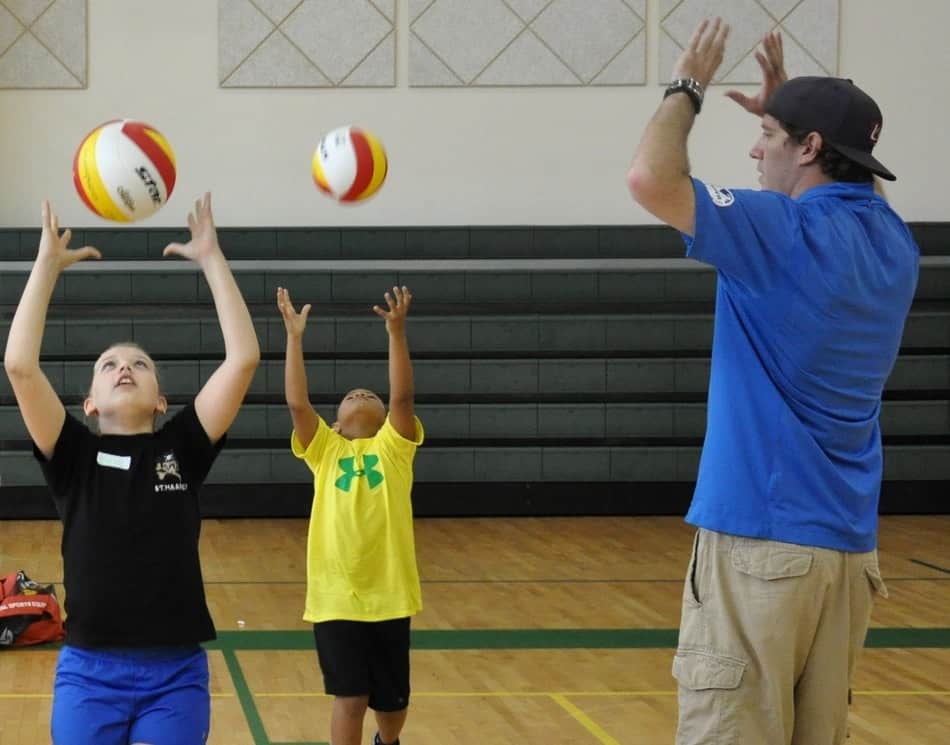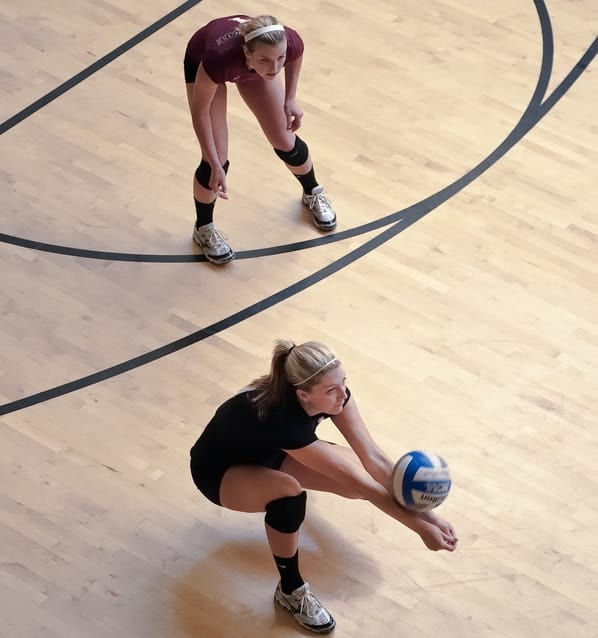Before you can take a random group of people and divide them into teams and expect them to play a decent volleyball game, it’s helpful to spend at least a little time going over some basics. Of course, the rules will need to be explained, but for most people, it will be just as important to learn some basic skills as well.

The basic skills in volleyball that should be demonstrated and practiced before actually playing are passing, volleying, and serving the ball.
This article will be a collection of drills that coaches, teachers, and parents can use in helping their young athletes learn the fundamental skills that you need to be successful at volleyball. By learning to be consistent with these skills, players will have much more fun because they will be able to get involved and have the courage to compete.
These individual volleyball challenges and drills are written with young people at least 9 or 10 years old, but they are suitable for much older beginners as well.
Beginner Volleyball Passing Drills
Passing is what many people refer to as “bumping” the ball. The player is clasping their hands together and using their arms to bounce the ball in the direction they want to pass it.
The proper term for this is a platform pass, but it’s often called passing, digging or bumping.

Bouncing Digs
For this drill, you begin by bouncing the ball one time in front of yourself, sending the ball a little higher than your head. Then stepping forward and bending your knees, you practice digging the ball.
Pass the ball straight up into the air, using your legs to push your pass higher into the air if needed. You do this by moving into a squatting position just before contacting the ball, then push with your legs during the pass, generating more power in your dig. After each pass, let the ball come down and bounce, then pass every second time the ball is coming down.
The challenge here is to find a good rhythm, stay in control, and see how long you can keep a streak going of passing every second time the ball comes down.
Wall Digs
In this drill, you stand about 6 feet away from a flat wall with a tall ceiling. You toss the ball up against the wall at least twice as your height. When the ball bounces off and comes back down, you dig it back up, aiming for the same spot.
You will need to use your legs to generate the power behind the bounce. Make sure not to swing your arms, that is a bad habit to start and causes all kinds of problems when you’re playing in a volleyball game.
If this is too challenging, to begin with, let the ball bounce in front of you before you dig. Make sure you use your legs to push your pass back up high enough on the wall.
Clapping Digs
In this drill, you do everything without letting the ball hit the ground. You’re going to begin by throwing the ball into the air straight up in front of you (use both hands in an underhand toss). A good height would be at least twice your height.
Then as soon as the ball is on it’s way up, clap your hands behind your back, then get ready to dig as it comes back down. Pass it straight back up into the air, and then catch it when it comes back down.
This takes some coordination and is great for learning to control the ball while you also have other things to pay attention to.
To take this challenge to the next level, try clapping behind your back and then in front before going for your dig.
Spinning Digs
This is similar to Clapping Digs, but instead of clapping, when you toss the ball into the air, you’ll spin around on the spot and then get ready to dig the ball.
Make sure you’re throwing the ball high enough to give yourself time, but also in a controlled way so it will come straight back down. You also want to spin quickly and then have a second to re-orient to track where the ball is coming down and adjust underneath it.
Once you’re good at spinning whichever way feels natural, challenge yourself and switch directions!
If you would like to learn more about passing and digs, visit this article called: What Is A Dig In Volleyball? Lessons, Drills, And Techniques
Beginner Volleying Drills
Volleying is when you use both hands in an overhand motion to receive and pass the ball back up using your fingers. Sometimes beginners think they’re supposed to use their fingertips and are scared of just how to touch the ball. Although it may feel strange at first, with practice this will become easier and natural.

Holding your hands out just a few inches in front of your face, with fingers and thumbs outstretched, you want your thumbs and forefingers just a couple of inches apart. Mainly use your thumbs and first 2 fingers on each hand to quickly absorb the ball and flick it back out of your hands.
This is called volleying, but the person whose job it is to do most of the volleying is called the setter. That’s why you’ll also hear it called setting. When you’re volleying or setting, have in mind that you really are setting up one of your teammates for a good play. You don’t want to just pop it up in the air, you want to make it easy for them to make a great shot!
Bouncing Sets
This drill is exactly the same as Bouncing Digs above, but this time you’ll volley it instead.
Start by bouncing the ball very hard on the ground in front of you with both hands, sending the ball straight up overhead. Now, step under the ball and volley it straight back up in the air. Then catch the ball on its way back down.
If you have trouble volleying the ball back high into the air, use your legs to do a squatting motion during your set and then push with your legs to generate more power.
Clapping Sets
This is similar to the Clapping Digs above. You throw the ball overhead (using both hands to underhand toss) and then clap your hands in front of your face while it’s in the air.
Volley it straight back up in the air and then catch it again before it touches the ground.
In this drill clapping behind your back becomes awkward and makes it really hard to practice good technique, so once you’re good at it, take it up a level by clapping twice or three times while the ball is in the air. Can you get more than 3?
Spinning Sets
Just like the spinning digs, you’re going to spin in your spot while the ball is in the air. Try to stay in a very tight circle, throw the ball straight up, spin around, set it straight back up and then catch it.
If you’re struggling, make sure to throw the ball high and get your hands in a ready position while you’re spinning. Make sure you’re moving underneath the ball so that you can set it straight back up into the air.
Remember the way to make this more challenging is to spin the opposite direction.
Turning Sets
For this drill, you’re going to toss the ball nice and high and set it straight up to yourself and keep it going. Now in between each set, don’t do a complete spin, but take a step moving in a gradual motion to turn your body around on your spot.
The idea is that after you’ve set the ball to yourself 4-6 times, you’ve done a complete turn, but kept your focus and control and not running all over. Make sure to always be aiming to volley straight back up in the air.
If you’re ready to learn more about setting and volleying, check out: How to Set a Volleyball: A Beginner’s Guide

Beginner Volleyball Spiking Drills
Spiking in volleyball is also called attacking, hitting or when you’re successful, killing the ball. A spike is when you use one hand, overhead to slap the ball with your whole hand like you’re hitting it with a paddle. This is an offensive skill that you’re using to try to score on your opponent.
You want to hit the ball with your hand like as if you’re giving the ball a big high-5. Spread your fingers out, but hit it with mainly the palm of your hand.
Wall Spikes
Begin about 10 to 15 feet away from a flat wall. Toss the ball overhead, this toss doesn’t have to be very high. You want to reach up high and strike the ball as high as you can swing.
Now spike the ball down to where it will hit the floor a few feet in front of the wall. The ball should bounce off the floor, hit the wall and bounce back up so you can catch it and repeat.
This drill can be fun and exciting and it’s tempting to just spike, spike, spike! But keep in mind when you do that you’re probably not using very good technique and you’ll be building a bad habit.
Would you like help serving the ball underhand? That can be so difficult for beginners! Check out this article for the best tips to help you succeed!
Photo credits:
Feature image by Erich Westendarp from Pixabay
Youth volleyball camp image by USAG- Humphreys on flickr.com: https://creativecommons.org/licenses/by/2.0/, cropped.
Passing image by Tucker Hammerstrom on flickr.com: https://creativecommons.org/licenses/by-nd/2.0/, cropped.
Volleying silhouette by Clker-Free-Vector-Images from Pixabay
Children volleying image by USAG- Humphreys on flickr.com: https://creativecommons.org/licenses/by/2.0/, cropped.
Recent Posts
Athletes, listen up! Do you have a closet full of old jerseys, sweatpants, and tees that you just can't seem to part with? Well, dust them off, because you're sitting on a goldmine of fashion...
You may have heard, or you may have noticed, that there's been a change to the rule about double contact in volleyball. In 2022, an experimental rule change began to be implemented, where the double...
